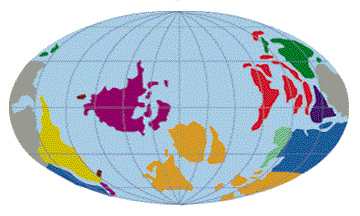Click on image for full size
Windows Original
Related links:
For comparison, read about the formation of Jupiter's atmosphere.
Earth's Primordial Atmosphere
Scientists ask many questions. One of the questions they like to ask is "Where did the atmosphere come from?" As always, scientists chip in with many different, and sometimes conflicting answers. Some scientists say that there was no atmosphere to start with, that the Sun, in its T-Tauri phase blew away the atmosphere with a strong wind. Other scientists point to evidence that comets may have brought water vapor to Earth and the other terrestrial planets. Different scientists think that the very first atmosphere of the Earth must have been made of the same material as the sun and stars, with the same relative amounts of each element as those bodies. They say that it was too hot for gases to condense or rain to the ground, so there was no ocean. One thing they seem to agree upon however, is that the atmosphere we started with is nothing like the atmosphere we have today. You may ask, "How do they know that?"Well, one way to tell is by measuring the amounts of different elements. What scientists learned from these measurements is that the amount of nitrogen in the Earth's atmosphere is 10,000 more that it should be if the atmosphere was the same as the sun and stars. This means that all the extra nitrogen in the Earth's atmosphere is new and must have come from somewhere. Moreover, with small planets like the Earth, Mars and Venus the atmosphere will eventually drift away unless it is replenished somehow. Scientists call the new atmosphere a secondary atmosphere, and they think all the new gases came from volcanoes. This suggests that, with Earth at least, the atmosphere is continually replenished by volcanic activity.












